Did you know that out of tragic necessity, India’s Mumbai Zoo is rapidly transforming into a taxidermy museum. Since they are unable to replace animals that die in their cramped and filthy cages, zoo officials have concluded that it would be better to stuff ‘expired’ animals and subsequently put them on display. Hence, the zoo’s remaining collection of roughly 750 living mammals, birds and reptiles are waiting to die, at which point they will become a task for the taxidermist to ensure that people come to see them even after death.
Albania’s Tirana Zoo is an animal prison where most of the inmates live in tiny rooms lined with tiles like shoddy hospitals. Much like people in Karachi, people in Tirana throw food and cigarettes into the cages, stick their fingers in to touch the animals and love to vandalise fencing.
My third example of a bad zoo is in a country that is walled-off from the rest of the world. North Korea's Pyongyang Central Zoo’s 5,000 animals live in grim and isolated conditions. If the Bristol Zoo was shut down last year after 186 years because the pandemic was a blow to them , surely any zoo that can no longer afford maintenance as a zoo should be shut down. And is the concept of the zoos even worth the moral cost?
From blatant demonstrations of mastery over beasts to a narrative of benevolent protection of animal species, the “educational day out” model of zoos emerged and they got rebranded as conservatories. This is the image of the zoo I grew up with ― the good civic institution that lovingly cared for animals. Almost everyone has vivid childhood memories of visiting Karachi Zoological and Botanical Garden, formerly known as Gandhi Garden and commonly referred to as the Karachi Zoo. The oldest memory that I have of visiting the zoo is when I was five years old and in KG-II, and our school took us for a picnic at the zoo. Those were the days when there were no malls or amusement parks, and parents as well as schools would arrange outings and day trips to the zoo and the children could not be happier.
I clearly remember the small park with a small hill in front of the lion cage, and my bestie and I chose to sit on the slope to have our picnic lunch. But that was not the first time that I went to the zoo. There is a picture of my first birthday and dressed in a yellow organza frock, I am proudly standing with the deer enclosure on the right and bird cages on the left, as if I owned them. All these memories and my love for animals come from my grandmother who always insisted that one must have at least one pet in the house.
Over the years, the zoo has changed a great deal and so have our attitudes. Today people have little or empathy for animals. But we’ll get to that later. Back to another photo from my childhood when I am 10 and striking a pose beside the golden lions that have guarded the main gate entrance for decades. Every child who visits the zoo has that customary photo taken. As malls, amusement parks, water parks, and several other fancy recreational facilities emerged, the footfall in the zoo decreased also because the place started becoming neglected. So it wasn’t until five years ago, when I visited the zoo with my nieces to show them animals and more importantly to pass on to them, the love and empathy for animals that my grandmother inculcated in me since my childhood. But this time round, I was surprised and sad to see that the cages were mostly empty and if they weren’t, they were occupied by sad looking lethargic animals.
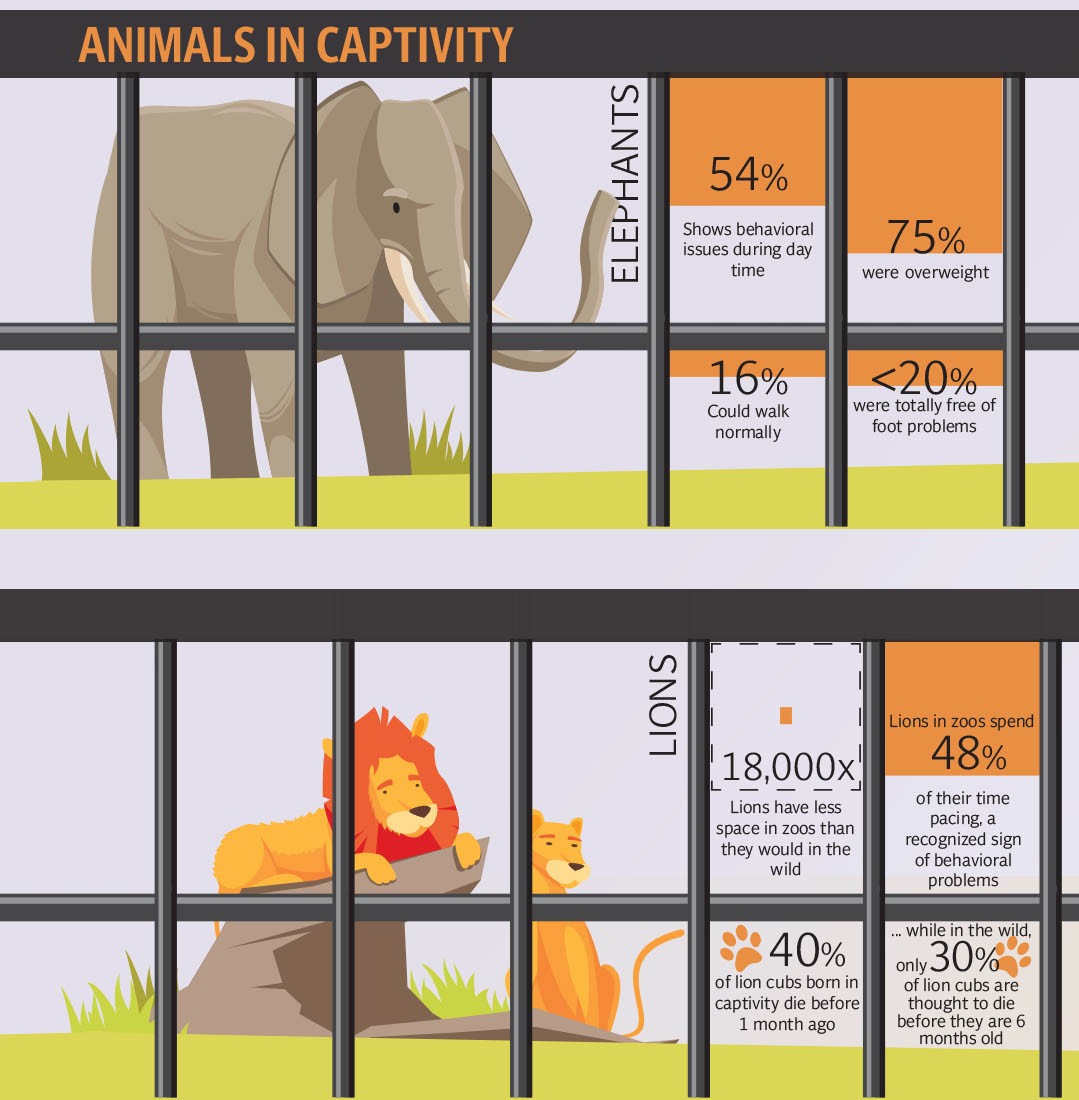 DESIGN BY: IBRAHIM YAHYA
DESIGN BY: IBRAHIM YAHYA
A jail for animals
Instead of the 33-acre zoo being a facility to create an awareness among children about different animal species and develop love for animals, the Karachi Zoo become a jail for animals trapped in cages in poor living conditions. What is supposed to resemble their natural habitat where they roam freely is a distressing, foul smelling enclosure.
Out of the 500 animals that the zoo houses, over 50 species appear to be in distress. “The team in the zoo is working within the available capacity and finances,” says Ayub. “The animals are given a diet prescribed by the zoologist and doctor, but there are only 10 untrained zoo keepers to look after the animals. They are doing the job because of their work experience with the animals, which is why the animals are friendly with them as they provide them food and medicine.”
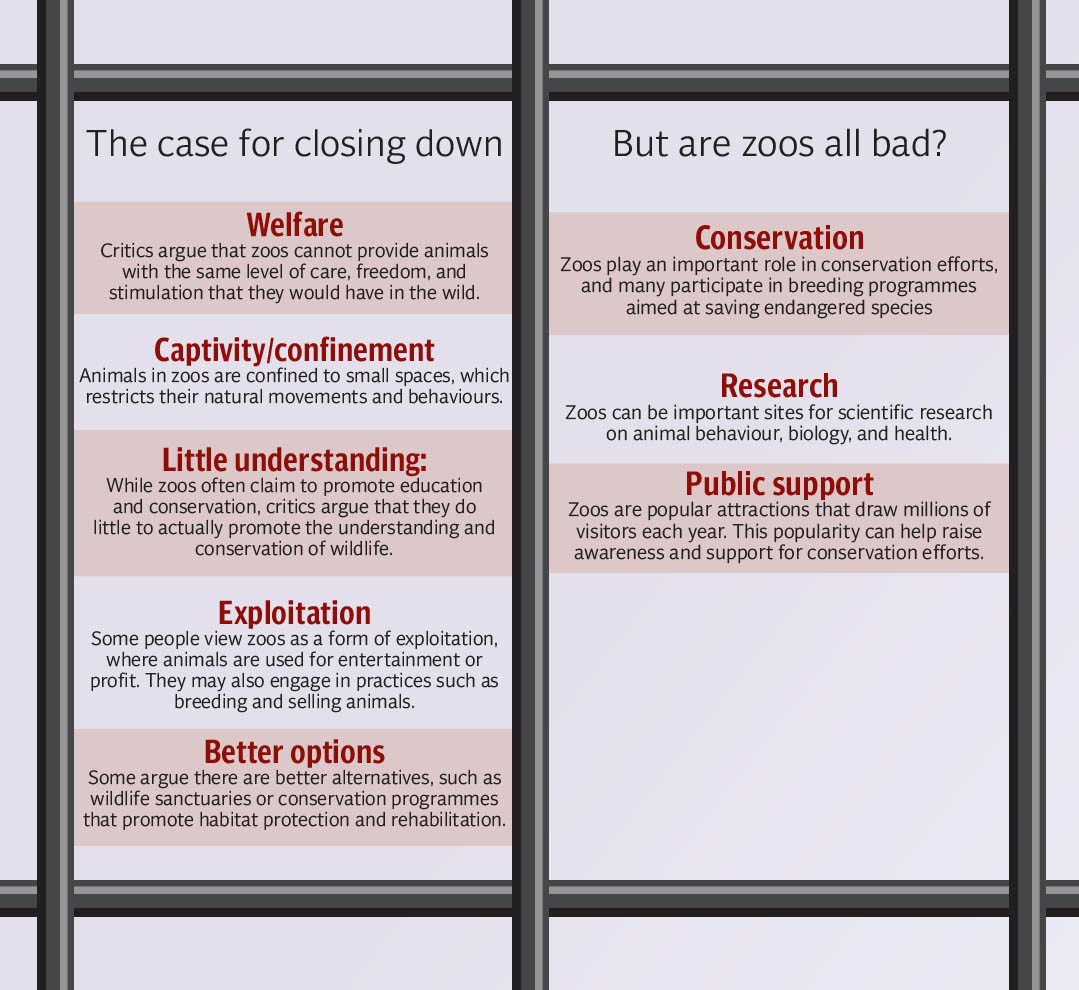 DESIGN BY: IBRAHIM YAHYA
DESIGN BY: IBRAHIM YAHYA
Can captive animals return to the wild?
After the 17 year-old elephant Noor Jahan’s demise following a prolonged illness, Madubhala, the other 17-year-old elephant will be shifted to the Safari Park by the end of June, where according to Kunwar Ayub, the zoo director, a sanctuary is under construction. “We will shift her under the supervision of the Four Paws (a global animal welfare organisation based in Vienna, Austria) team after a proper space has been built,” he says. “The ground there is being levelled to enable her to walk and relax.
Noor Jahan’s illness and demise was not an overnight issue, but years of neglect and corruption that had grave consequences for the pachyderm. The death has infuriated people enough for them to demand the closure of the zoo and shifting the animals to their natural habitat. But the zoo director disagrees. “It is not so simple to shift the animals in the zoo to a natural habitat because almost all of them have been bred in a controlled environment and they cannot survive in the wild,” he explains, adding that he has plans to build sanctuaries for wild animals, once Madhubala has been shifted.
Ayub also spoke about plans over the next ten years to construct a safari for lions, deer, and elephants where people will be able to see animals live and roam freely in their natural habitat.
Untrained zoo staff
The Karachi zoo has one doctor and two zoologists, whereas the requirement from the zoo administrator is to have at least two doctors and a small hospital on premises. About 10 zookeepers or caretakers have no training or knowledge of the particular species they take care of are assigned to look after 500 animals. Basically, they are low-paid staff hired by the zoo.
“We know the right amount of food to be given, and we are given a chart daily to provide food or meds to the animals and we just follow that,” says Ali Khan*, an old zoo keeper. He also said that sometimes the food is not enough so they manage from the food left over from previous days, but more or less the animals are given the desired and prescribed diet according to the chart. “If the weather changes or it rains or if the animal is lethargic, the diet is altered,” says Khan, who observes any abnormal behaviour among animals that he feeds daily. “For instance, in the deer enclosure, there are 12 deers and at feeding time, they come running for food. If one doesn’t, then we know that it is not well and we inform the doctor.”
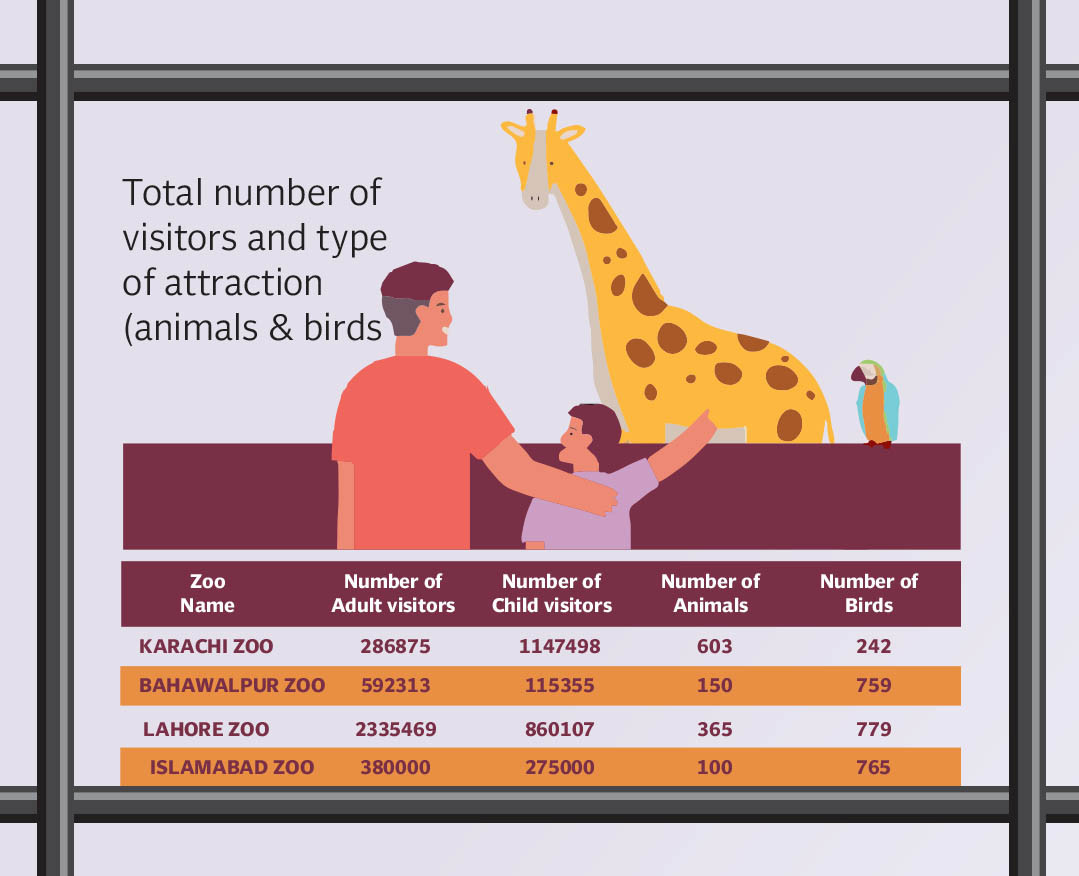 DESIGN BY: IBRAHIM YAHYA
DESIGN BY: IBRAHIM YAHYA
Low footfall
I stopped going to the zoo after a certain age, not just because I had grown up, but also because it had nothing new or attractive to offer. The aquarium, fascinating for children, was closed down because of maintenance expenses and the decreasing revenue was not even enough to provide food for the species. The reptile area, the boat ride in the filthy green, stinky lake, and a train ride around the zoo is still functional, but most visitors hardly use the revenue-generating entertainment and wander around after buying a Rs xx ticket. In my childhood and even until many years later, it was a norm for families to visit the zoo every six months or take a visitor from another city to the zoo, but that doesn’t happen anymore. The ‘visitors’ mostly comprise young men loitering or aimlessly hanging around killing time, because of which families and women are reluctant to go to the zoo.
“We used to go to the zoo in summer vacations,” says Seemin Naz, a 43-year-old private employee, reminiscing about her childhood. “There used to be a special day for women and men were not allowed that day. But I never took my children to the zoo, because by then the place had lost its charm and Safari park had come up. Lately, the zoo in Bahria Town is a much better option in terms of crowd, facilities, cleanliness, and safety.
I’m visiting because it’s cheap and nearby as my sister is in Karachi for Eid, and we thought of bringing her children to the zoo,” says Khajista Parveen, who came to visit the zoo after six years. “Wednesday is women-only day, so it’s safe and we can roam around freely and even go on rides, otherwise there are men around who catcall and stare. There are no security guards so we don’t feel safe.”
Ayub believes that the low footfall in the zoo is only because of these young men loitering around who annoy families and even animals. “We will make it a family place and groups of boys will not be allowed entry,” he says. “This way we can make it safe for families and women.”
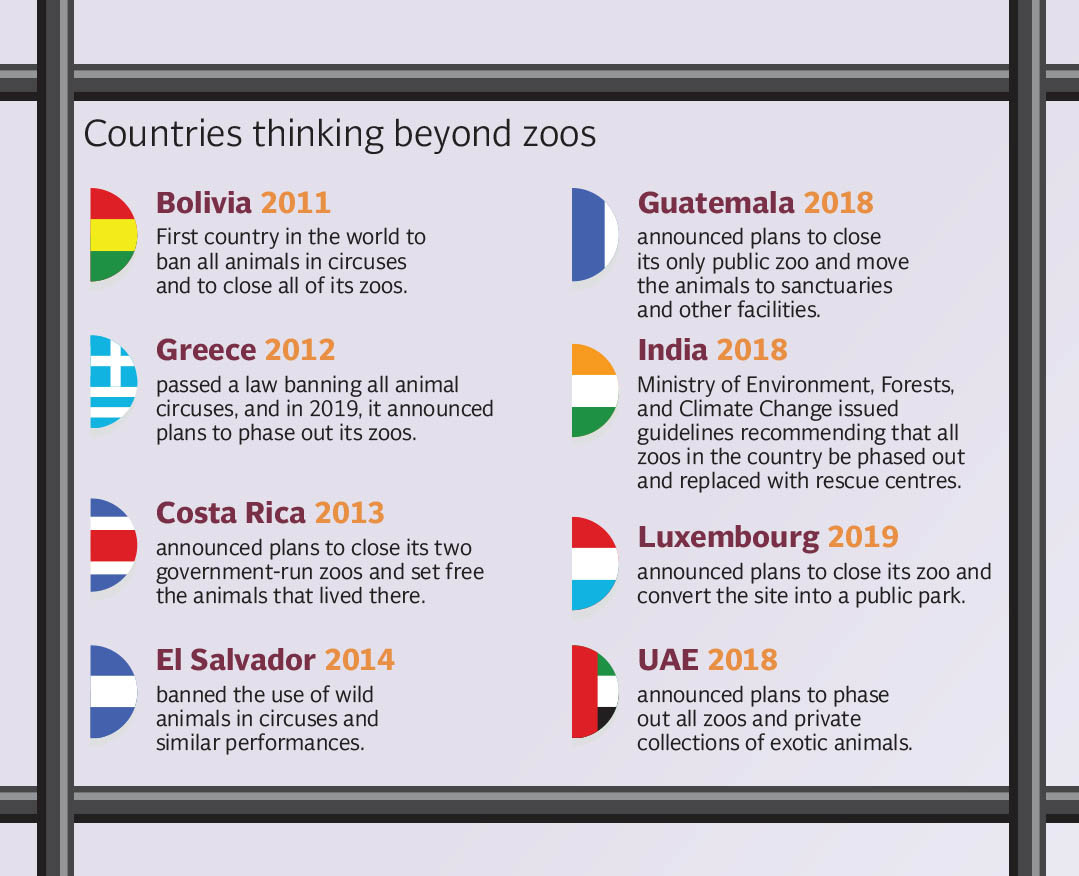 DESIGN BY: IBRAHIM YAHYA
DESIGN BY: IBRAHIM YAHYA
No education and no empathy
The uneducated public that is unaware and oblivious about how to treat animals causes harm and damage to the animals, and are an issue for women’s safety as well because of their hooliganism. In the past, cases have been reported where people have shown no regard or respect for animals and they have spat pan on crocodiles, thrown stones on monkeys and lions to see them react. They come dangerously close to the grills around the cages to take selfies. They tease the elephants during rides which annoyed the elephant and the result could have been a disaster if the carriage full of people and children tied on the elephant could have ended up in an accident. There have been incidents when women or young girls were being harassed and if zoo caretakers or guards intervened, there would be clashes and the culprits would gang up on the guards.
Grandiose plans
“We will make sanctuaries and shift the animals as we have plenty of space in Safari Park that can be utilised,” says Ayub. “Closing down the zoo is not going to happen, nor is it a solution. The facilities can be upgraded and improved.”
Ayub also discussed that the zoo gardens are a valuable botanical space. He plans to have a hall constructed for the purpose of lectures on botany and the 200-year-old trees present there. “We also have plans for the zoo keepers to be trained by Four Paws, so that they can help if any animal is going through a serious illness.”
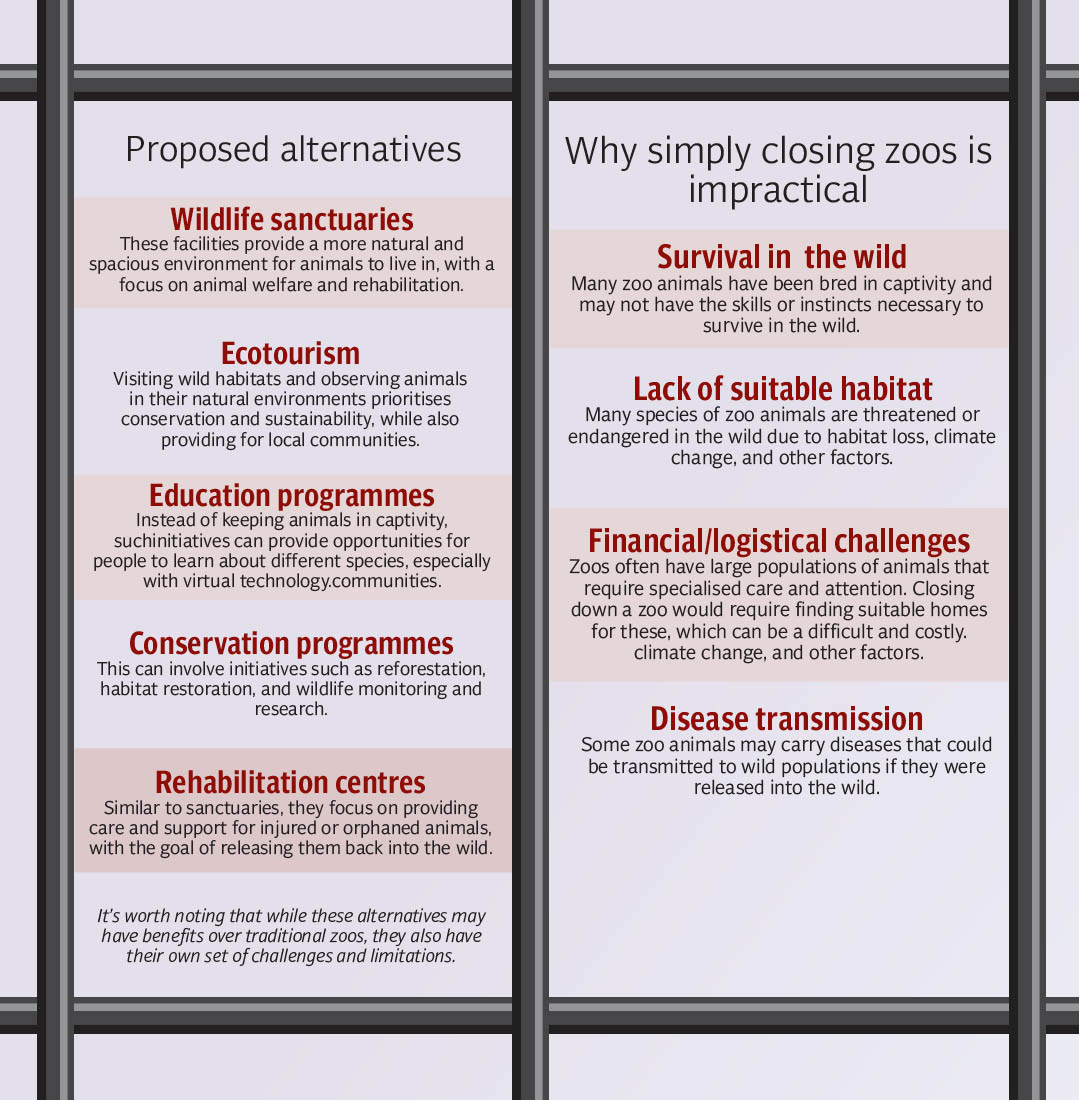 DESIGN BY: IBRAHIM YAHYA
DESIGN BY: IBRAHIM YAHYA
Should Karachi zoo be closed?
Whether the zoo should be closed down or not and when and where should the animals be moved to is being continually debated since the past two months, and animal activists are pushing a very active campaign to shut down the zoo.
“Closing the zoo is not the solution, but changing the zoo management is,” suggests Azlan Shah, an animal enthusiast. “The zoo should be changed into a sanctuary if the management wants, but almost anyone who is pulling the strings here does not have a degree or training in animal behaviour and sciences.”
Shah feels that Madhubala should be shifted at the earliest, but there are several protocols involved. “She will need time to acclimatise to her new surroundings at the safari zoo and eventually she can meet and make friends with the other two elephants in the zoo. Also her caretakers and mother must move with her to keep her emotionally comfortable.”
The animal enthusiast recommends that a team of educated animal lovers and activists should be organised by the zoo management to provide voluntary services for the well-being of the zoo animals. “Sanctuaries and safaris help conservation of animals,” he says. “There are only 20,000 lions in the wild, while the rest of the lions are in either farms, sanctuaries or zoos. Similarly pandas are only found in sanctuaries and farms and none in the wild. Conservation prevents them from becoming extinct. Animals breed only when they are stress free and on a proper diet. In the Karachi Zoo, almost every animal has bred which means that they are healthy and getting proper food. If a lion is sleeping throughout the day, it is fine because lions sleep 20 hours a day. So posting pictures and calling out for empathy isn’t right.”
Shah pointed out animals should be kept in specially designated cages which is not being done at the Karachi zoo. “For example, parrots cannot live in cages designed for peacocks,” he says. “It eventually creates problems and distresses the species.”
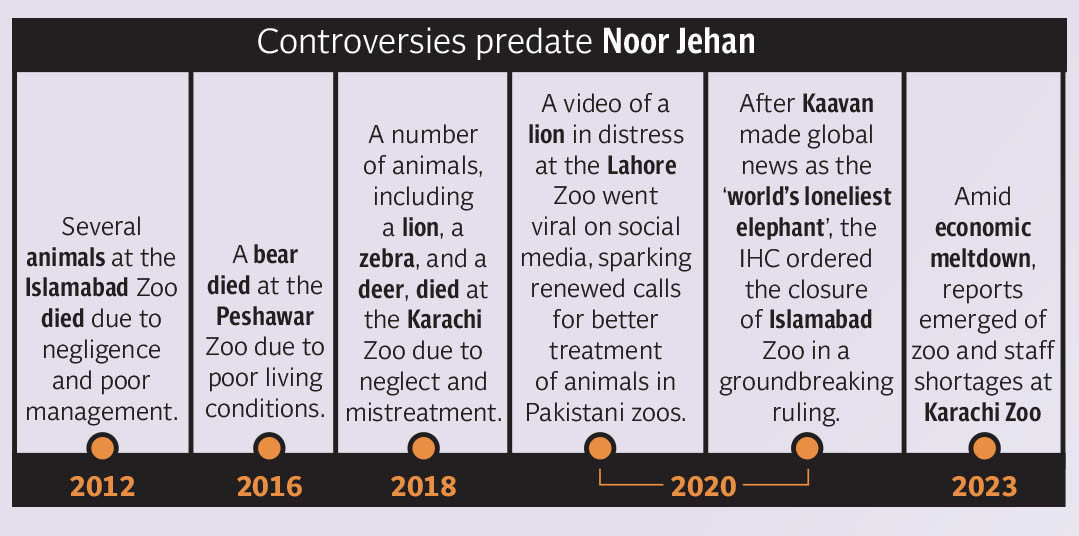 DESIGN BY: IBRAHIM YAHYA
DESIGN BY: IBRAHIM YAHYA
The garden of misery and death
Walking around the zoo, I came to the road where the elephants majestically walked in my childhood ― the most exciting part of visiting the zoo. We would climb up the 5-6 steps for the elephant ride, which was discontinued later due to animal rights violations and safety issues. The stairs are still there, the elephants are missing, as is the laughter and excited shrieks of overjoyed children. The road is dusty and deserted, the isolated elephant enclosure is empty and literally stinks to high heaven. The animals look miserable, the trees look lifeless despite sunlight, water, and oxygen. There is a general air of doom and gloom, an empty and sad atmosphere of mourning for a fellow species/being, a death not natural but due to sheer negligence.
I left the zoo with Ayub’s revelation ringing in my ears. “Noor Jahan’s condition deteriorated in the last month of her life, but three months ago, when I was reinstated as the director, I knew she would die, no one could have saved her, we did all what we could but that was her destiny.”
